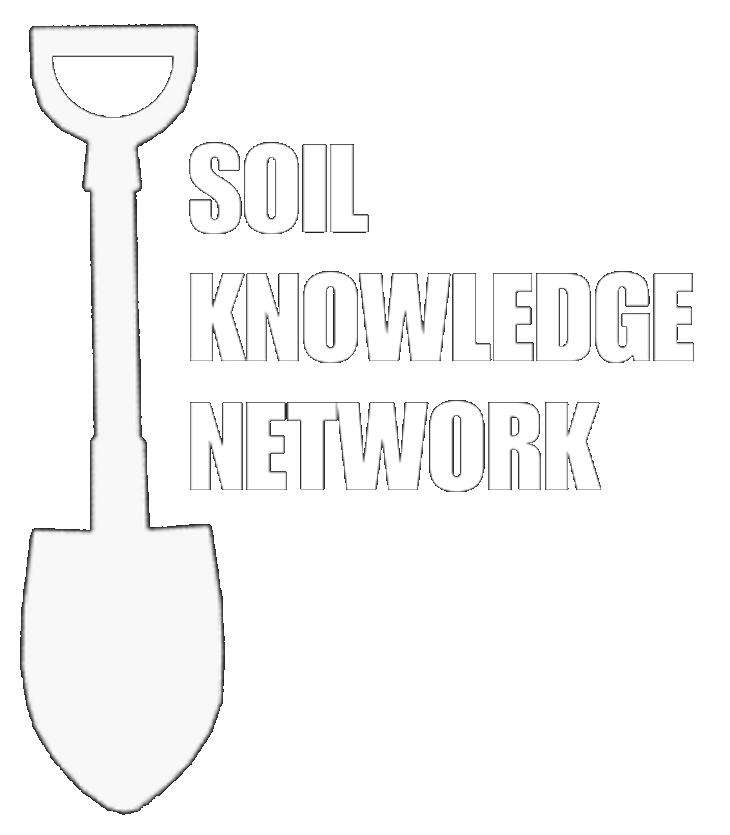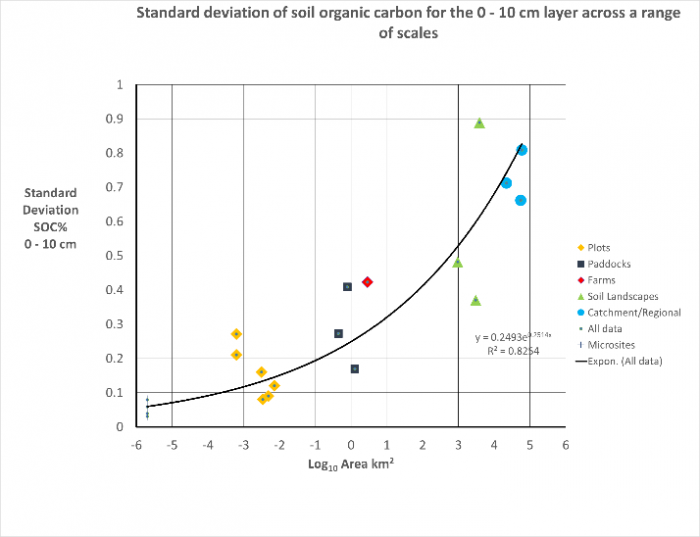Brian Murphy, NSW Soil Knowledge Network
A recent Forum on soil organic carbon provided many valuable insights about soil organic carbon and the sequestration of carbon as soil organic carbon (SOC). However, a number of issues remained unresolved including misconceptions about soil organic carbon and the sequestration of carbon into soils.
1. Measurement of SOC% and SOC Stocks
A clear presentation about measuring soil organic carbon emphasised the need for measurements to be fit for purpose. Although the presentation perhaps needed some more specific explanations, it was clear that for many purposes, the measure of SOC% as g of SOC/100g of air-dry soil was sufficient. It was not necessary to have estimates of bulk density of the soil. Measures of SOC% are less costly and more easily obtained. SOC% is sufficient for many purposes of assessing many aspects of soil condition and soil health. In fact, it maybe a more reliable assessment of several aspects of soil condition and soil health because many soil properties such as aggregate stability, buffering capacity, soil strength and even water holding capacity, have had relationships with SOC% established.
b. The SOC% for a field or paddock can be rapidly assessed using a simple depth-controlled coring device (foot operated), with perhaps a single bulked sample being used to provide and indicator value for a field at absolute minimal cost.
In fact, SOC% maybe the mythical readily available and easily measured parameter of SOC that several people have been calling for. Perhaps some research is needed into the broader applicability of SOC%?
c. Adding bulk density to the SOC% can provide an estimate of SOC stocks (t/ha), but this adds substantially to the difficulty and costs of measurement. Certainly, if the objective is to sequester carbon, a measurement of SOC stocks to a high degree of accuracy and reproducibility is required for actual trading. However, reconnaissance values of SOC% can provide useful indicator values of starting levels of SOC stocks and where there is potential to sequester carbon as SOC (Badgery et al. 2020).
d. An important aspect of measurement overlooked was the influence of scale. While the three levels of scale, local, regional and national were mentioned, the local scale is critical as often being the operational level of soil carbon sequestration projects. At the operational level, the “local” scale includes plot, field or paddock, farm and district. Many soil carbon projects designed to sequester carbon operate at the field scale. The sampling regimes to estimate soil carbon stocks vary considerably across these scales within “local scale”. At the plot and field scale, design-based sampling regimes are often the best performing, while as the area becomes larger (farm and district) other environmental, management and pedological factors come into play, and model-based sampling regimes are the best performing sampling regimes.
e. No mention was made of design-based or model-based sampling regimes, although this is key to estimating soil carbon stocks at the different scales. Design-based sampling regimes have the advantage of being relatively straightforward and readily audited. Model-based sampling regimes can be complex and can be more difficult to audit.
f. One aspect of sampling not mentioned was the potential for the use of paired sites across times of sampling. This can greatly reduce variability (minimises spatial variability between times of sampling) and the potential to obtain statistically detectable changes in SOC stocks. Murray Lark, a prominent soil scientist has suggested the value of this approach (Lark 2009).
2. Changes in variability with scale
A graph was presented that suggested that the variability of SOC decreased with scale. This is not necessarily true and depends on how variability is measured. There are other ways of assessing variability than CV or on a per unit area basis. A set of real data from central west NSW shows what happens to standard deviation as the area increases. Clearly the variability increases. This makes sense because as the area increases, the area encompasses a wider range of climate and soil types. As mention many times in the Forum, climate and soil type are the main driver of SOC% and SOC stocks. As more soil types and climate regimes are included, the variability logically increases (see Figure 1). The use of CV can be a misleading statistic because it is so dominated by the value of the mean. The raw value of the SD is a better guide to the actual expected variability, rather than some “relative variability” as measured by CV. It can be argued that the value of CV is to compare the variability between different soil properties, but if the variability of a single soil property, SOC in this case, is being considered, it is potentially more informative to use the standard deviation or perhaps the standard error?
The implication of this graph for sampling also becomes apparent. At the field and paddock scale, design-based sampling is effective, but once the scale is beyond the field scale, it becomes necessary to implement model-based sampling regimes as climate, soil type and management factors begin to affect SOC.
3. SOC and Land Management
A statement was made that land management has little impact on SOC % or SOC stocks. However, land management actions can have a large impact on biomass production at a site, the nutrient balance at a site and the rate of decomposition of SOC at a site. What is true is that in the overall impact, land management actions can have less impact than climate and soil type on biomass production, nutrient balance and rates of decomposition of SOC. Policy development based on the assumption that land management has little impact on SOC may lead to perverse outcomes.
One of the problems of assessing the impact of land management on levels of SOC is in defining or describing land management practices. A rather arbitrary distinction was made between “land management practices” and “land use”. However, as pointed out by one presenter at the Forum, the relevance of such a distinction is confounded by such practices as the inclusion of pasture phases within cropping rotations. It does highlight the problem of defining exactly what management actions are included within a “management practice”. One of the obvious dilemmas of assessing the effects of say “conservation tillage” compared to “conventional tillage” is that the real differences in management actions between these two practices maybe minimal. Stubble burning under current day “conventional tillage” may involve a cool burn in late April or early May just prior to sowing and perhaps one or two cultivations prior to sowing. Nothing like what might be considered traditional “conventional tillage” of an early hot burn immediately following harvest and up to 7 cultivations with a disc plow prior to sowing. Any differences in SOC levels between “conventional tillage” and “conservation tillage” as now practiced, maybe masked by differences in biomass production, nutrient management and rates of SOC decomposition that arise because of other agronomic or nutrient management practices. Perhaps it is not surprising that it has become more difficult to detect changes in SOC levels based on what are effectively quite subtle changes in land management actions. Emphasis should be placed on the effect the land management actions have on biomass production, nutrient management and SOC decomposition.
The evidence suggests that differences in SOC levels that can be attributed to land management practices are not so much a consequence of differences in the commonly recognised groupings of land management based on terms such as “conservation tillage” or “direct drilling”. Rather they are a result of better agronomic and soil management that optimise biomass production, nutrient management and SOC decomposition for the accumulation of SOC in the soil. Within a soil type/ climate unit, there can be wide variety of SOC levels as shown by the data from the SCaRP Project (Soil Research Special issue Vol 51, 2013, see Figure 2). For each soil type/ climate unit there will be an achievable potential soil carbon level and a land manager should be able to see where a field fits into this potential level of SOC. If land management has not been able to provide the expected biomass production, there is a lack of nutrients or an excessive amount of SOC decomposition, the SOC levels will be less than the potential, and there is scope for carbon sequestration as SOC using a change in land management. However, the required change in land management is likely to be considerably more complex and specialised than the simple change from “conventional tillage” to “conservation tillage”. The acquisition of such specialised detailed data on land management is difficult and rarely available to use in analysing data on SOC stocks (Macdonald et al. 2013).
An example of the variation of SOC stocks within a soil type/climate unit is given below, using data from the SCaRP project in central west NSW (Badgery et al. 2013; 2020). There are a wide range of SOC stocks and land management is likely to have a large effect on this variation. It is unlikely that using relatively simple classifications of land management into groupings such as “direct drill” or “conventional tillage” can account for this variation. Overall factors such as long-term crop management, rotations, pasture management, nutrient management, agronomic management etc. are more likely to have affected the SOC stocks in the soils. Given the importance of biomass production to maintain SOC levels, even a pasture phase can be ineffective in maintaining SOC stocks if the pasture phase has poor plant growth or has been heavily grazed.
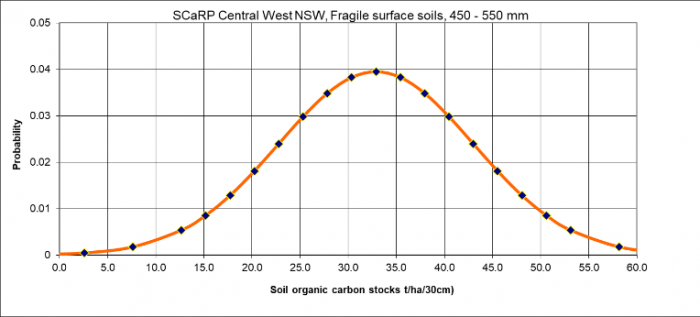
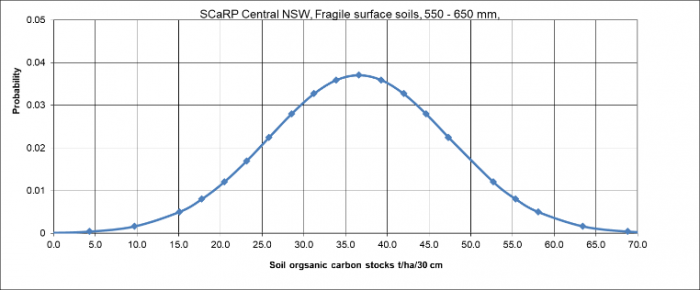
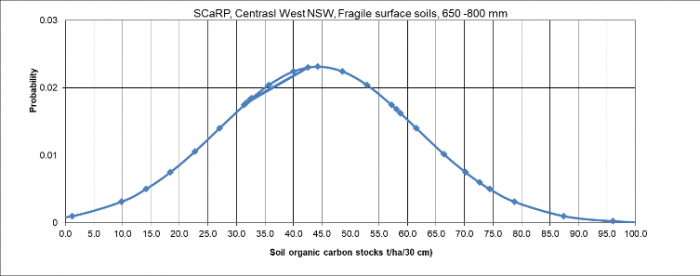
Important implications of Figure 2 are:
- A likely expected value of SOC stocks for the soil type/climate unit is about 33 t/ha/30 cm for the Red Fragile soils in the 450 to 550 mm rain zone. Corresponding values for 550 to 650 mm and 650 to 800 mm rainfall zones are 37 and 44 t/ha/30cm respectively.
- A land manager with SOC stocks less than these expected values may have the opportunity to sequester carbon by improving land management practices. Exactly what those land management practices are will depend on the region and any input costs required to implement changes in land management practices. A consideration is that, given the current price of carbon in carbon trading, It is unlikely that income from carbon trading alone will provide sufficient return to justify changes in land management that sequester carbon ($50 to $60 /tonne of C in 2020, based on Clean Energy Regulator of Australia[1]). It would be hoped that any returns from carbon trading could assist in changing land management practices that result in improved productivity.
- The land management practices to achieve the higher levels of soil carbon stocks are unlikely to be accounted for by the somewhat simplified grouping of land management practices used in the past. Terms such as conservation tillage, direct drilling or conventional tillage can no longer encapsulate the suite of management practices required to achieve high levels of soil carbon stocks within a soil type/climate zone. Consideration has to be given more complex and sophisticated aspects of agronomic management, nutrient management and the capacity to improve plant productivity and conversion of plant biomass to soil organic carbon.
[1]Clean Energy Regulator. Australian Government, Canberra. http://www.cleanenergyregulator.gov.au/Infohub/Markets/buying-accus
4. Soil Health and Global Sustainable Development Goals
The global sustainable development goals that concern soils include food security, action on climate change, water security and provision of energy. The sequestration of carbon is designed to contribute to the goal of action on climate change. However, soils also can contribute to food security and the provision of clean water. Soils can contribute to multiple goals. The problem is if you adopt some “better” agriculture practices you increase production per unit area, but also increase emissions. Hence in increasing food security and perhaps water security, by using less water per unit of production, there may be an increase in emissions of greenhouse gases. At present it appears there is no provision for “better” practices that have the potential to reduce emissions per unit of production, and so overall, can have an overall potential benefit. The use of emissions intensity which is emissions per unit of production is one option to account for this (Henry et al. 2012).
Conclusion
The Forum provided a valuable day with all speakers making well considered and informative presentations. Clearly there is still a way to go before projects that sequester and trade in carbon become common practice. More thought is needed on the value of SOC% as an indicator of soil condition and as an indicator of the suitability of a field for a project to sequester carbon.
Further information: Key considerations in sequestering carbon as soil organic carbon
References
Badgery, WB, Simmons, AT, Murphy, BW, Rawson, A, Andersson, K, Lonergen, VE and van der Ren, R (2013). Relationship between environmental and land use variables on soil C levels at the regional scale in Central NSW, Australia. Soil Research 51, 645 – 656.
Badgery, W, Murphy, B, Cowie, A, Orgill, S, Rawson, Simmons, A and Crean, J. (2020). Soil carbon market-based instrument pilot – the sequestration of soil organic carbon for the purpose of obtaining carbon credits. Soil Research 59, 1-23.
Henry B, Charmley E, Eckard R, Gaughan JB, Hegarty R (2012). Livestock production in a changing climate: adaptation and mitigation research in Australia. Crop and Pasture Science 63:191–202.
Lark, RM (2009). Estimating the regional mean status and change of soil properties: two distinct objectives for soil survey. European Journal of Soil Science 60, 748-756.
Macdonald, LM, Herrman, T and Baldock, JA. (2013). Combining management based indices with environmental parameters to explain regional variation in soil carbon under dryland cropping in South Australia. Soil Research 51, 738 – 747.
